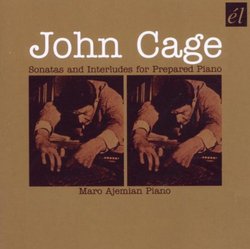A Good Place to Start
Discophage | France | 10/10/2007
(5 out of 5 stars)
"Not being a diehard Cage admirer and collector, I am not particularly familiar with the discography of his epoch-making Sonatas and Interludes for Prepared Piano (1946-8), and therefore can give no informed opinion as to whether this one can be considered as one of "the best" - if such notion has any meaning, especially with this composer. What are the criterias anayway after which one can assess if a recording of the Sonatas and Interludes is "better" than another? The notes aren't very difficult to play, and Cage's composition isn't really about "notes", I'd think. It is about color, about the particular gamut of sounds that the prepared piano will produce. I anticipate that any preference is, here even more than anywhere else, going to be a very subjective matter.
Anyway, I had been surveying the piano music of Cowell (see my reviews of Henry Cowell plays his own Piano Music, Sorrel Doris Hays Plays the Piano Music of Henry Cowell, Wizards & Wildmen, New Music - Piano Compositions By Henry Cowell / Brown, Hays, Kubera, Cahill and Sound Forms For Piano) and have just tackled Nancarrow's Studies for Player Piano (Nancarrow: Studies for Player Piano, Player Piano 1: Nancarrow Vol. 1), so I thought I needed at least one CD of Cage's magnum opus (I have a couple on LP, but my turntable is presently o-o-o anyway). This recording by Maro Ajemian seemed a good place to start: it was the first one (recorded in 1950 and released a year later on 2, 3 or 4 LPs - the various sources differ on that detail - on the Dial label) and Ajemian is the pieces' dedicatee and first performer of the first four, fresh from the composer's pen (Cage premiered the others). In 1949 she also gave the ground-breaking Carnegie Hall concert of them which established overnight the stature of Cage as a leading composer of the avant-garde. One can therefore suppose that this is how Cage wanted them to sound - and so much he admitted, considering this recording "the definitive version" and advising subsequent performers wanting "to adhere to past models", to "listen to the recording by Maro Ajemian and then attempt to imitate that preparation". Yet that statement must be somewhat qualified: I doubt that Cage unequivocally requested of his performers that they "adhere to past models" and really wanted the Sonatas to sound in any particular fashion, if his famous statement (reproduced in the liner notes) is to be taken seriously: "My favorite music is the music I haven't yet heard. I don't hear the music I write: I write in order to hear the music I haven't yet heard." But still, for all the reasons stated above, this recording has unique authority and legitimacy.
This is the same recording as the one that was licensed by CRI and first released by them on LP in 1965, and subsequently reissued on CD in the mid-nineties (it is still available: Sonatas and Interludes for Prepared Piano). On this new Él reissue, the sound is excellent, with perceptible tape hiss that I personally do not find bothering, and good piano definition, the mono sound translating into no loss of space and body that I can perceive. The liner notes are more interesting in the CRI release though, but these are available for download from New World Records.
By the way, nothing in the liner notes gives any clue that Maro Ajemian (born 1920 or 1924, the biographies differ - died in 1978), an American pianist of Armenian descent, much involved in the new music of Hovhaness, Cage, Cowell and Harrison in New York in the forties to sixties (she also gave the American premiere of Khachaturian's Piano Concerto in 1942), was, as the name doesn't necessarily indicate, a woman. No photo of her is featured on the disc. The CRI liner notes contain a good short biography and one can find another one (with photo) on the allmusicguide website.
And the music? I remember, the first time I listened to this piece, some 25+ years ago, exclaiming to myself: "what? THIS is IT?" This apparently simplistic, folk-song or ditty-like music, was what all the fuss was about? I didn't hear anything in it beyond the strange and sweet colors of the prepared piano. But remember: those were the last years of the overbearingly exclusive reign of "complexity" in music, at least in Europe. Gorecki, Pärt, Adams weren't yet around. Composers were barely starting to dare insert a tonal chord in their music back then - and these were frowned upon.
Now that so many composers seem to have relinquished any sense of self-criticism and self-exigency, I've come to recognize that, no, there is probably nothing to hear in the Sonatas and Interludes beyond the strange and sweet colors of the prepared piano. Yes, THIS is IT, this is what it is about: a sweet, dreamy, evocative, spellbinding, gamelan-inspired ritualistic music. I personally don't think it is great music (I find much more fodder in anything George Crumb wrote for piano), but it is agreeable, enjoyable, soothing and sweet.
"


 Track Listings (19) - Disc #1
Track Listings (19) - Disc #1